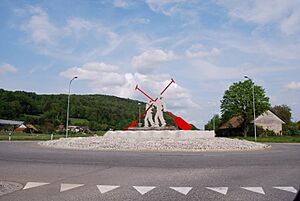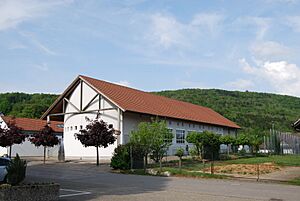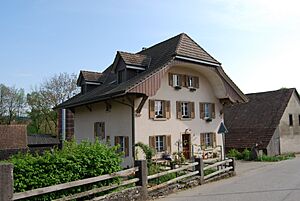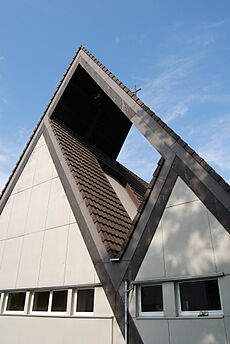Boningen facts for kids
Quick facts for kids
Boningen
|
||
|---|---|---|
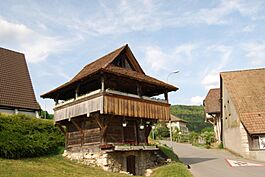 |
||
|
||
| Country | Switzerland | |
| Canton | Solothurn | |
| District | Olten | |
| Area | ||
| • Total | 2.76 km2 (1.07 sq mi) | |
| Elevation | 410 m (1,350 ft) | |
| Population
(Dec 2020 )
|
||
| • Total | 793 | |
| • Density | 287.3/km2 (744.2/sq mi) | |
| Postal code |
4618
|
|
| Surrounded by | Fulenbach, Gunzgen, Kappel, Murgenthal (AG), Olten, Rothrist (AG) | |
Boningen is a small town, also called a municipality, in Switzerland. It's located in the canton of Solothurn, within the Olten district.
Contents
History of Boningen
Boningen was first mentioned in official records in the year 1226. Back then, it was known as in villa Bonningen.
Geography of Boningen
Boningen covers an area of about 2.78 square kilometers (1.07 square miles). A large part of this land, about 38.1%, is used for farming. Forests cover another 27.7% of the area.
Around 25.5% of Boningen is built up with buildings and roads. About 9.4% of the land is made up of rivers or lakes. A very small part, 0.4%, is land that cannot be used for anything.
The town is located in the Olten district. It sits in an area called Aaregäu. This area is between the Aare river and the bottom of the Born mountain. Boningen includes the main village and a smaller settlement called Gsteigli.
Boningen's Coat of Arms
The coat of arms for Boningen has a special design. It shows a red pike fish and a red oar crossed over each other. The background color is silver. This design is called a blazon.
People and Population in Boningen
Boningen has a population of about 720 people. About 12% of the people living here are from other countries. In the last ten years, the population has grown by about 10.3%.
Most people in Boningen speak German. About 95.8% of the population uses German as their main language. Serbo-Croatian is the second most common language, spoken by 1.6% of residents. A small number of people also speak Italian or French.
In 2008, there were slightly more women than men in Boningen. About 49.2% of the population was male, and 50.8% was female. Many people, about 31.6%, were born in Boningen itself. Others were born in the same canton or elsewhere in Switzerland. About 8.8% of the population was born outside Switzerland.
The age groups in Boningen are quite varied. About 8.6% of the population are young children (0-6 years old). Teenagers (7-19 years old) make up 19.7% of the population. Adults between 25 and 44 years old are the largest group, at 36.3%.
Most people in Boningen are married. In 2000, there were 289 married people. There were also 297 single people. About 254 private homes were in the municipality. On average, each home had 2.5 people living in it.
Many homes, about 26.8%, had only one person living there. There were also many families with children. Most of the buildings in Boningen are single-family homes. Many of these homes were built between 1981 and 1990.
The chart below shows how Boningen's population has changed over time:

Boningen's Economy
In 2010, the unemployment rate in Boningen was 2.5%. This means a small number of people who wanted jobs could not find them.
Many people in Boningen work in different types of jobs.
- Some work in the primary sector, like farming. There were 21 people in this sector in 2008.
- Others work in the secondary sector. This includes jobs like manufacturing or construction. About 79 people worked here.
- The largest group works in the tertiary sector. These are service jobs, like sales or transportation. About 70 people worked in this sector.
In 2008, there were 146 full-time equivalent jobs in Boningen. Many of these jobs were in manufacturing. Others were in sales, retail, or moving goods.
Many people who live in Boningen travel to other towns for work. About 278 people leave Boningen to work elsewhere. Only 86 people come into Boningen for their jobs. Most people use a private car to get to work. About 12.4% use public transportation.
Religion in Boningen
Based on a 2000 survey, most people in Boningen are Roman Catholic. About 54.4% of the population belongs to this church. The next largest group, 31.4%, belongs to the Swiss Reformed Church.
A small number of people belong to other Christian churches. This includes Orthodox and Christian Catholic churches. There are also a few people who follow Islam or Buddhism. About 7.7% of the population does not belong to any church.
Education in Boningen
Many adults in Boningen have completed a good level of education. About 37.7% have finished upper secondary education. This is like high school. About 9% have gone on to higher education, like university.
During the 2010-2011 school year, Boningen had 63 students in its school system.
- There were 15 children in Kindergarten. This is for young children and is not required.
- There were 48 students in primary school. This is required for six years.
Students from Boningen who go to secondary school attend classes in a nearby town. This is because Boningen does not have its own secondary school. In 2000, 61 students from Boningen went to schools outside the town.
See also
 In Spanish: Boningen para niños
In Spanish: Boningen para niños





